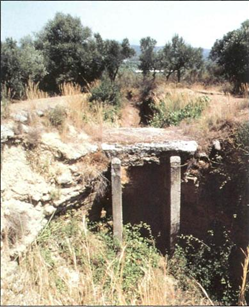Investigations in the vicinity of the palace of nestor
Romanou Traces of Mycenaean occupation have been found within the modern town of Romanou. A short distance to the northwest, a large flat-bottomed rectangu¬lar basin, ca. 200 χ 300 m (650 χ 975 feet) in a bend of the Selas River may have been the port of the Palace of Nestor in Mycenaean times, but is now entirely filled with silt.
Northeast of the village of Romanou, a low hill called Viglitsa affords a commanding view of the coast. Two early Mycenaean tholos tombs were built there (Fig. 35).
Figure 35. Interior of tholos at Viglitsa
Korres has recently clarified the history of this important site. The tombs appear to have been set into remains of earlier settlements, with traces of occupation of the 3rd and earlier 2nd millennium B.C. The earlier of the two tholos tombs was built in the 16th century the second slightly later. Finds from the tombs include a seal depicting a winged griffin and a terracotta box of the 12th century B.C. with a rare representation of a prehistoric Greek warship.
Tragana The village of Tragana sits near the western end of one of the principal ridges that slope down to the sea from the foothills of Mount Aigaleon. On its outskirts Ma-rinatos excavated one room of a house that contained finds exclusively of the Early Mycenaean period.23 The room con¬tained triton shells and more than one hundred pottery ves¬sels. Investigations by the Pylos Regional Archaeological Project suggest that this structure did not belong to a larger village or town. It is possible that the room was part of an isolated mansion, long abandoned by the time the Palace of Nestor was built.